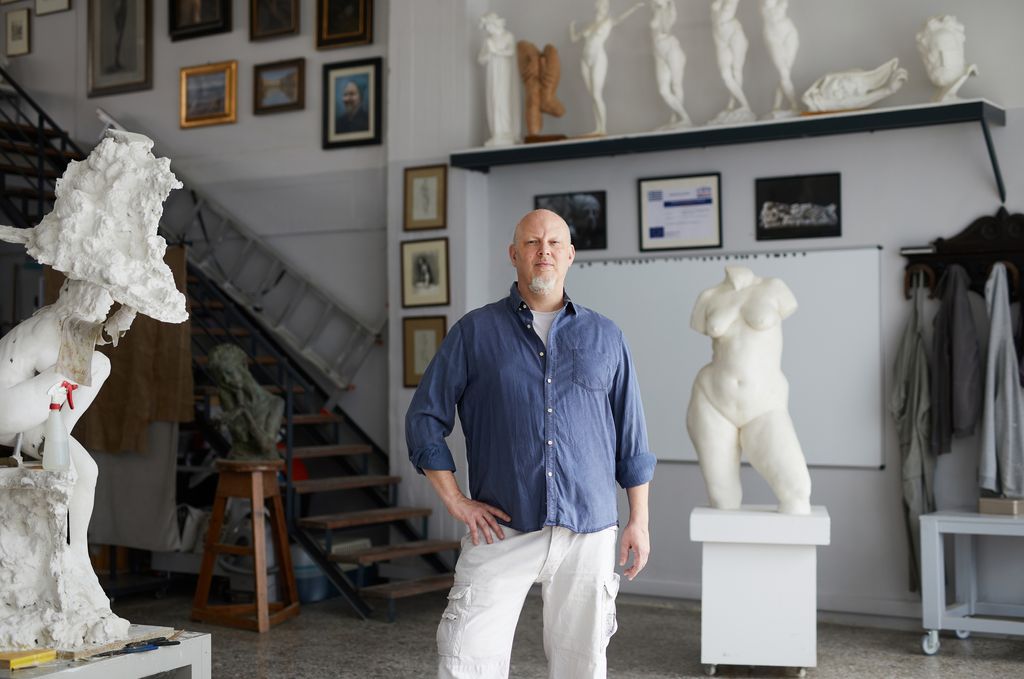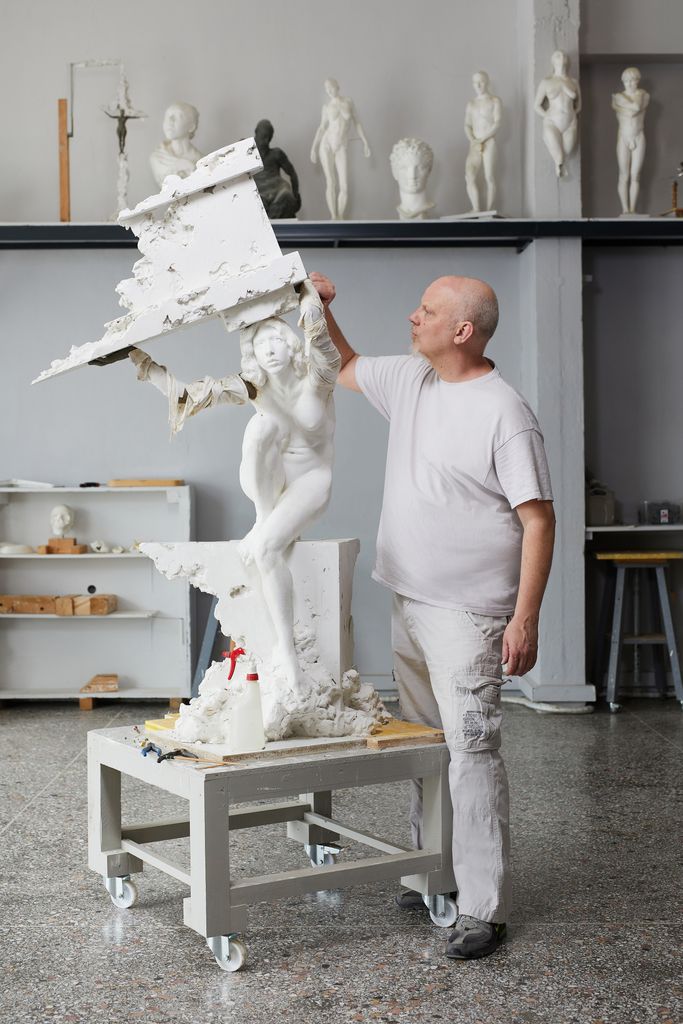Drawing in Space
Artist and instructor Robert Bodem teaches an innovative sculpting technique

Robert Bodem has taught workshops and a multimonth sculpture program at his Athens Sculpture Atelier since 2018. Photos by Dimitris Vlaikos
Drawing in Space
Artist and instructor Robert Bodem teaches an innovative sculpting technique
In a light-filled studio in Athens, Greece, Robert Bodem presses layers of clay around spare metal armatures, creating realistic sculptures of the human body in motion and in repose. The clay figures—some life-sized, some smaller and more intimate—are later cast in bronze, becoming sculptures that will be displayed in elegant homes and sun-filled gardens of art collectors around the world.
Bodem’s studio is also a classroom, where he teaches a sculpting technique he has refined over more than two decades—a methodology he calls “drawing in space.” The technique breaks down figurative sculpting into such a systematic process that he could teach it to anyone, he says.
“When you do high-quality figurative work, and people recognize that quality, almost the first thing out of their mouth is, ‘I could never do that.’ And that’s not the truth,” says Bodem (’95,’98). “With this curriculum and a good student with the right attitude and the right amount of effort, so much is possible.”
Bodem has taught workshops and a multimonth sculpture program at his Athens Sculpture Atelier since 2018. Before moving to Athens to be near his wife’s family, Bodem spent 20 years in Italy, directing the sculpture program he’d founded at the Florence Academy of Art. His classes draw students from across the globe. Some have become celebrated sculptors, with works on display in cathedrals, museums, public parks, and private collections. Others have become teachers themselves, opening their own ateliers in Spain, the Netherlands, and Israel, to name a few.
While teaching in Florence, Bodem distilled his sculpting methods into a studio manual for his students, which he titled Drawing in Space. He is working with a former student, British sculptor Poppy Field, to rewrite Drawing in Space and expects to self-publish the new volume as a full-color, hardcover book later this year.

“When you do high-quality figurative work, and people recognize that quality, almost the first thing out of their mouth is, ‘I could never do that.’ And that’s not the truth,” says Bodem.
The Box and The Egg
Bodem was a teenager in upstate New York when, following in the footsteps of his beloved high school art teacher, he enrolled in an art education program at Nazareth University in Rochester. An instructor there recognized his talent and encouraged him to set aside his teaching aspirations and pursue a studio career. Bodem transferred to BU, where he fell in love with sculpture.
“I was a 20-year-old kid carving trees with chainsaws and banging on wood and welding metal,” he says. “I enjoyed doing it every day.”
Bodem’s early sculptures were abstracts, but his ideas were often based on the human figure. After earning a BFA, he explored the figure further through drawing classes at the Florence Academy of Art, a school established in 1991 by Daniel Graves, an artist from Bodem’s hometown of Pittsford, N.Y. After months of drawing from life models at the very traditional academy, Bodem was finished with abstraction. He called Isabel McIlvain, a renowned figurative sculptor who was a CFA associate professor at the time, from a café in Milan and asked if he could return to Boston for graduate studies with her.
McIlvain taught Bodem a concept called “the box and the egg,” which has become the basis of his teaching curriculum. When blocking in a sculpture, Bodem always begins with the pelvis (the box) and moves on to the ribcage (the egg). Perfecting the placement of these underlying structures is vital, McIlvain taught him, because a figurative sculpture isn’t just about the surface that viewers can see; a great figurative sculpture has a sense of “internal-ness.”
“Whether it’s Greek figurative sculpture, Renaissance, the French Academic period, or the Baroque period—there’s an inside there,” Bodem says. “That was Isabel’s big teaching principle. I’ve altered it in ways, but that principle has been the basis for everything I’ve been doing for 25 years.”
At the end of his graduate studies, Bodem applied for and won CFA’s Esther B. and Albert S. Kahn Career Entry Award, which came with a $15,000 prize. He moved back to Italy, where the funds covered his living expenses as he attempted to launch a figurative sculpture program at the Florence Academy of Art to complement the drawing and painting programs Graves offered.
“In the beginning, he had just a couple of students, and we had to fill up space with drawing students so we could pay the rent,” says Graves. “In a couple of years, he took over the whole building, and it just kept growing and growing. His best students became teachers, and the program—there’s nothing I know of on this planet that comes close to it.”

One of those students was aspiring Dutch artist Sanne van Tongeren, who searched for years for a sculpture program that would help her master the human figure. She was thrilled to discover the Florence Academy of Art, where she studied with Bodem and later joined the faculty. In 2018, she returned to Amsterdam and opened Figura, the Dutch Academy of Figurative Sculpture, where she teaches her students to construct a box and an egg and connect them with contours. When she opened Figura, she says, her dream was to revive a form of classical art education that once thrived in the Netherlands.
“In the 17th century, we had great Dutch sculptors who were even teaching Italian sculptors,” she says, adding that the Rijksmuseum, the national art and history museum of the Netherlands, is filled with “beautiful three-dimensional artwork.”
Bodem says it’s gratifying to see his students spreading his methods in their corners of the world. And he’s proud of the dual career he’s built as a teacher and an artist. The two roles have always gone hand in hand. Experimenting with techniques in his studio teaches him lessons he can share with students, he says. Likewise, students come to him with difficulties he’s never encountered, and problem-solving with them teaches him lessons that elevate his own work.
As a sculptor, Bodem says, he strives to be inventive within a traditional art form. As a teacher, he continuously reevaluates his methods. In Florence, the sculpting program he taught was three years; now, he’s perfecting a program that offers the essential components of his training in just six months.
“I’m still innovating with this process that I’ve been developing for 25 years,” he says. “It’s never static.”